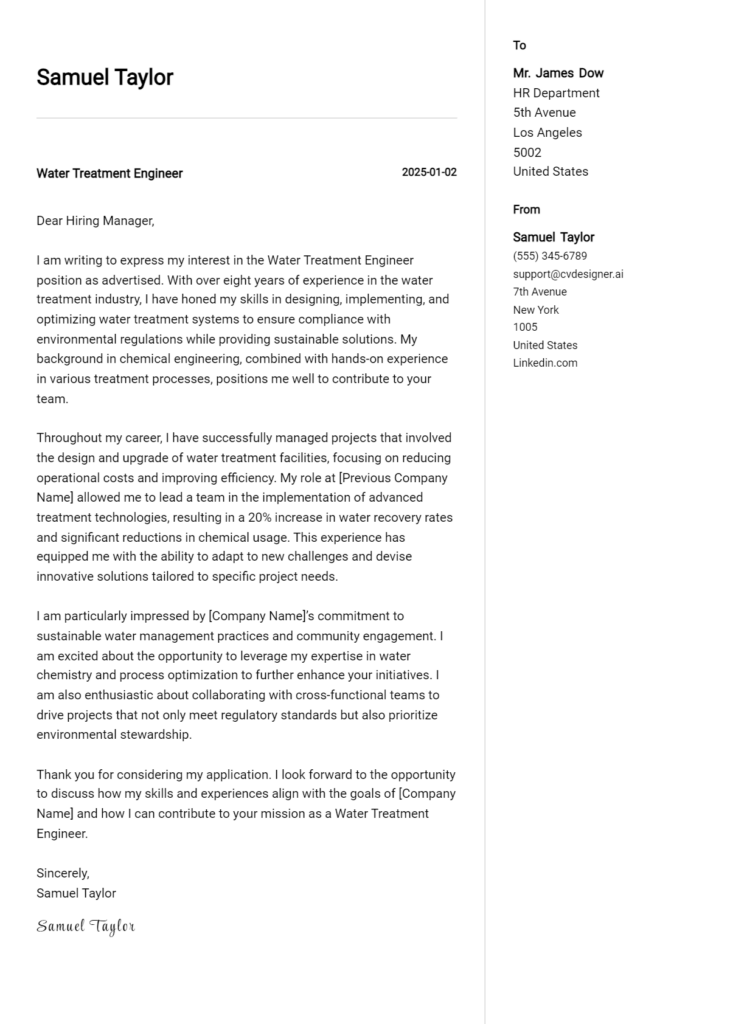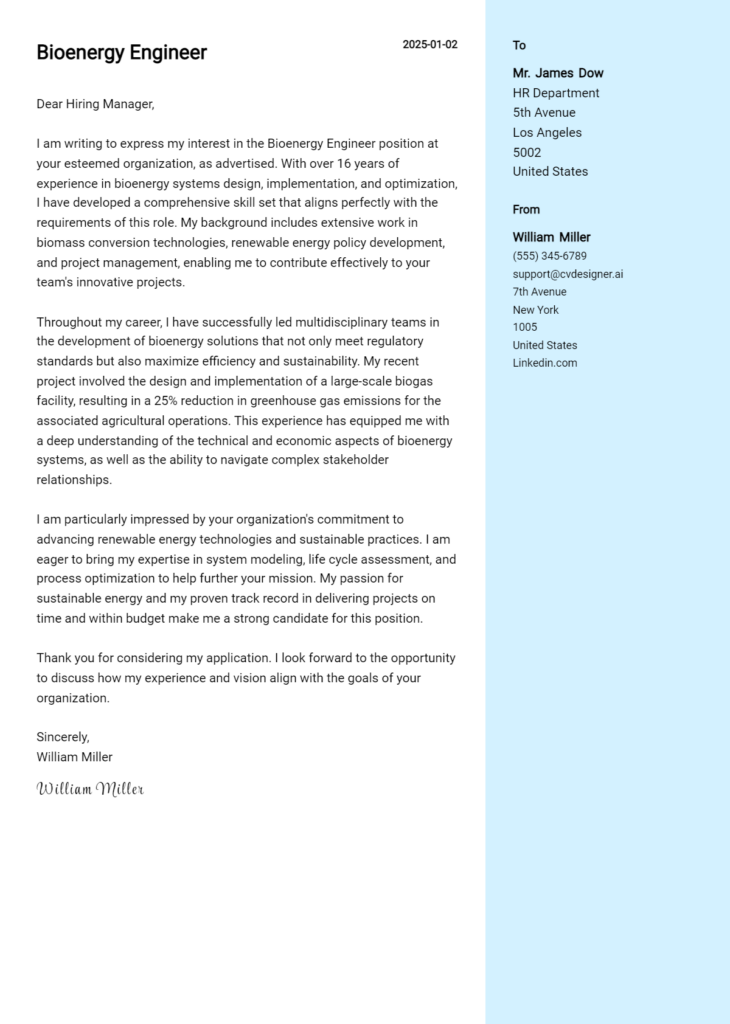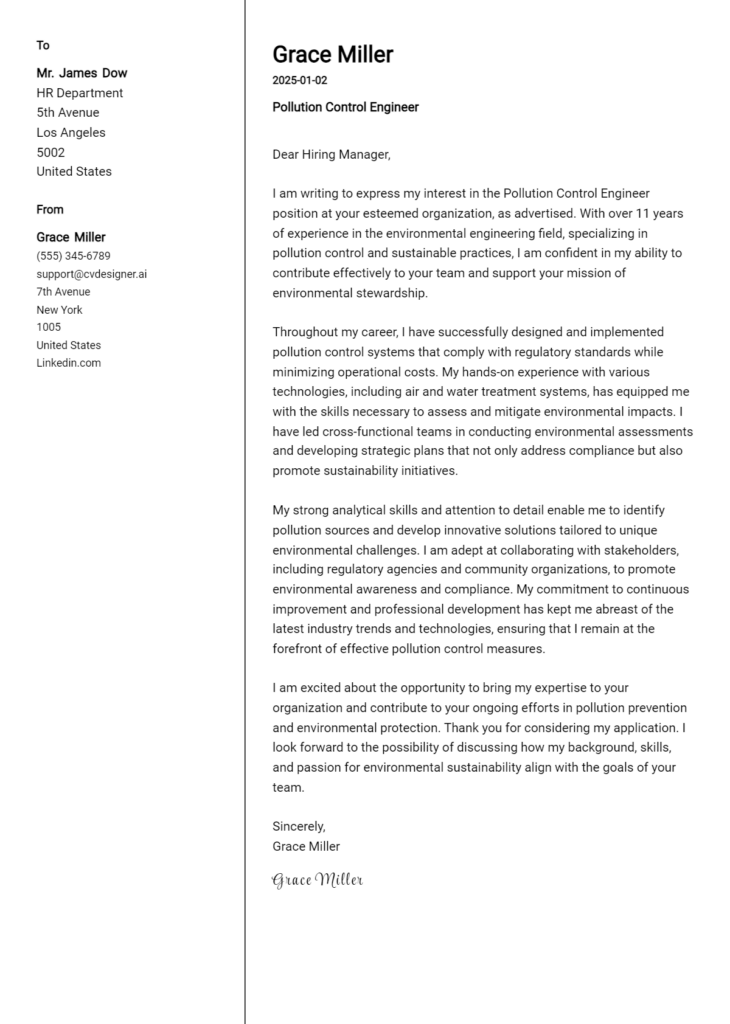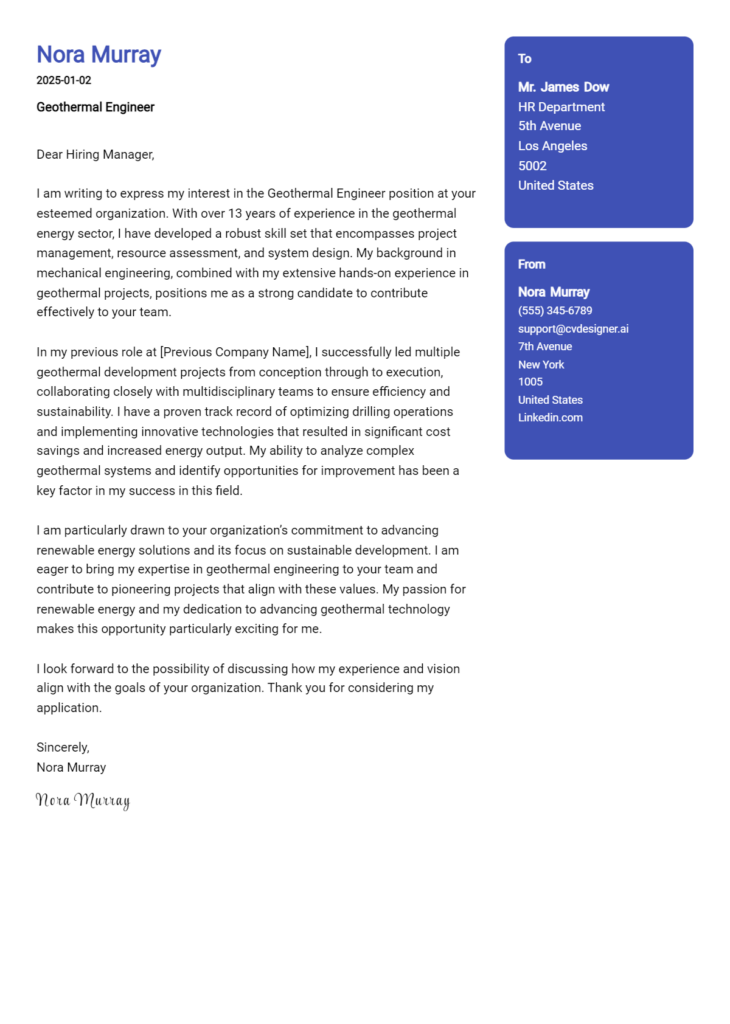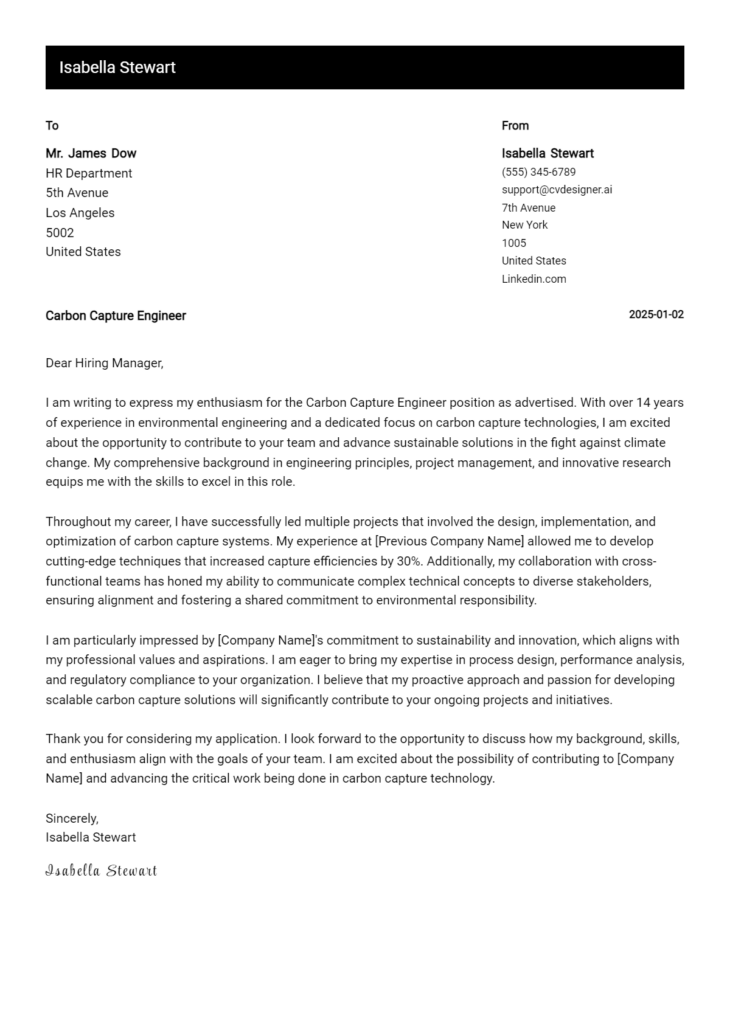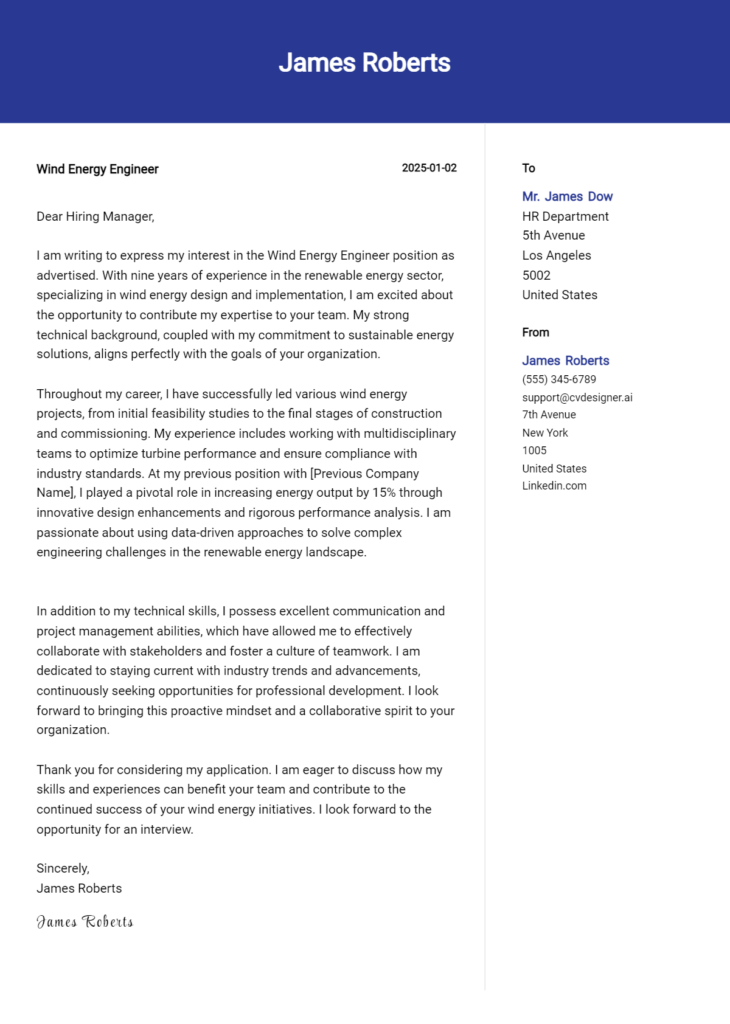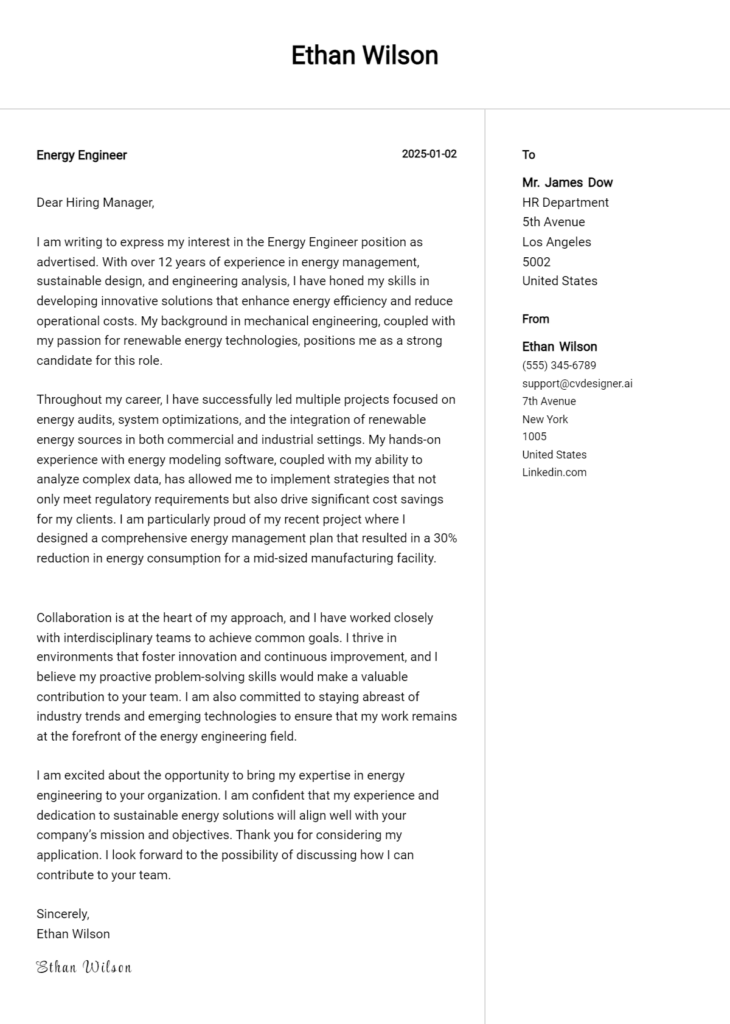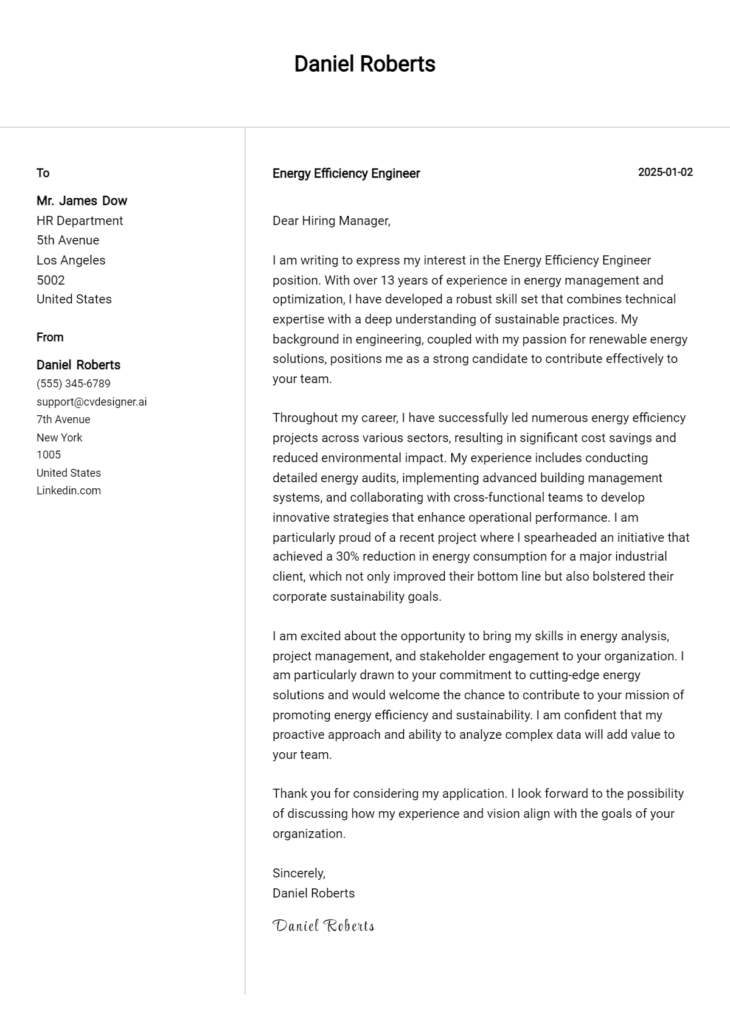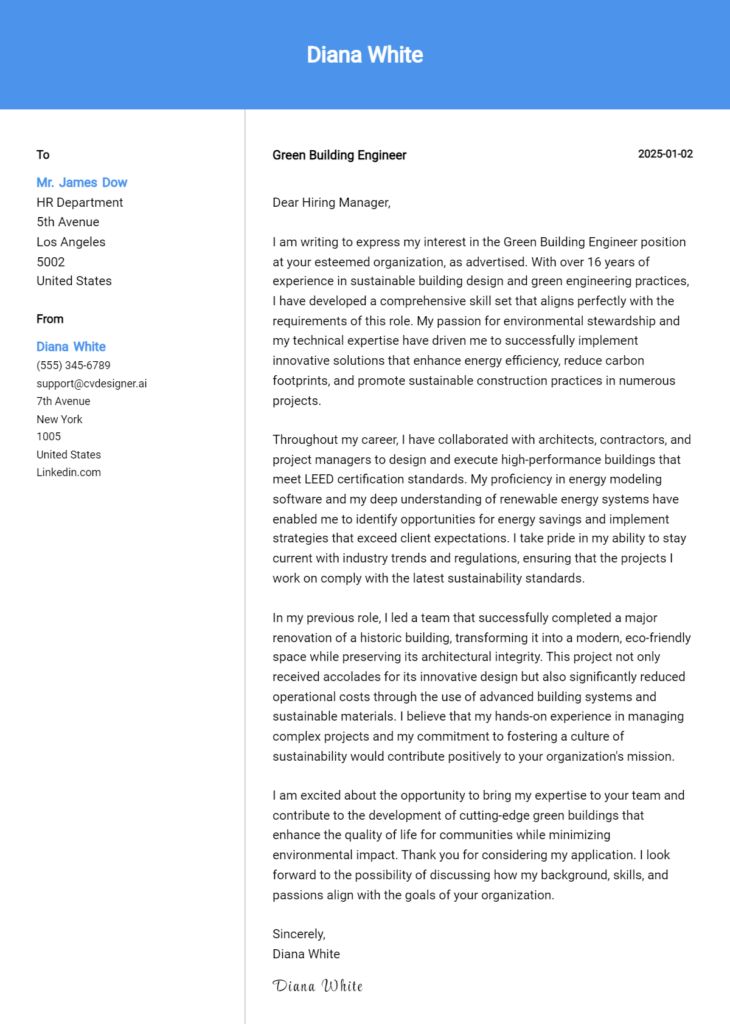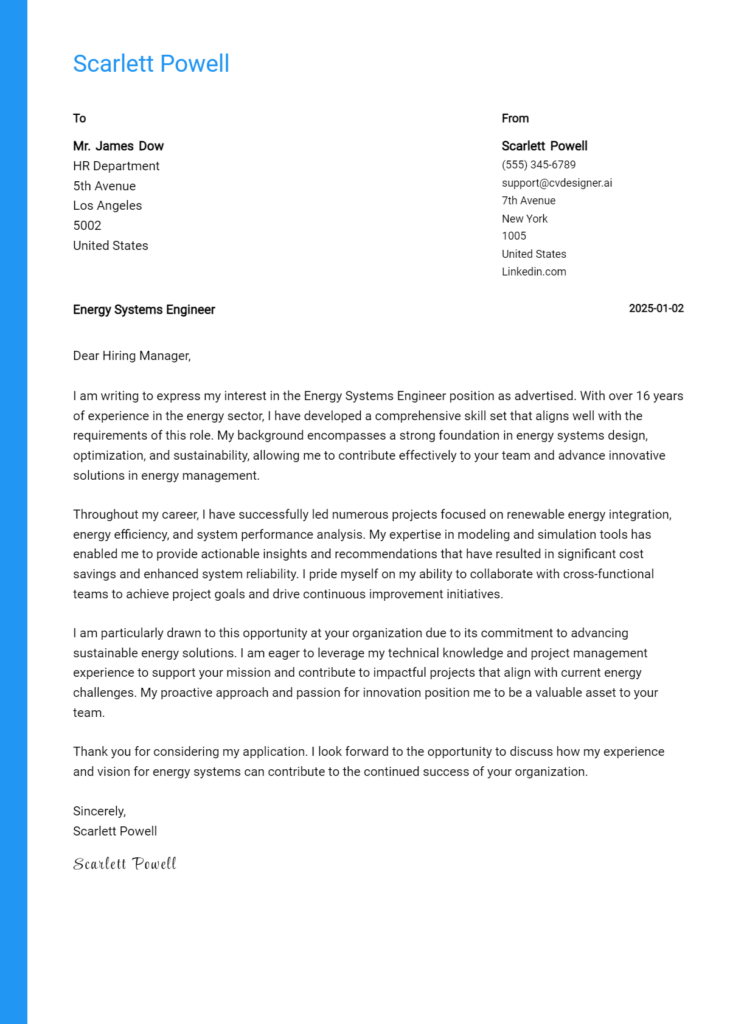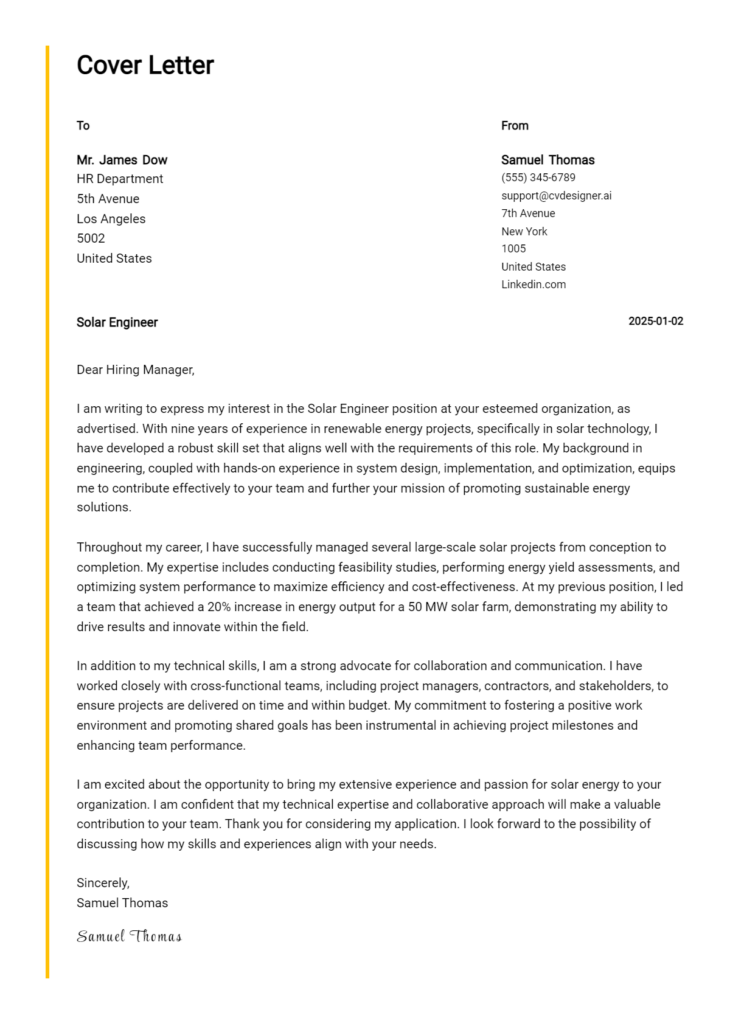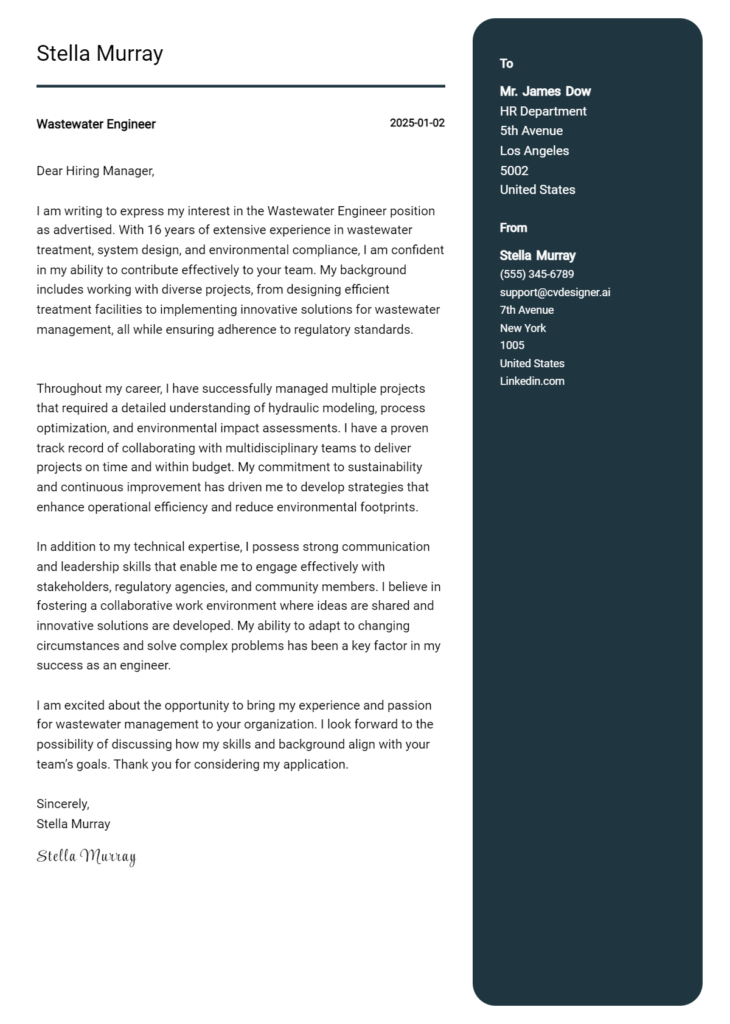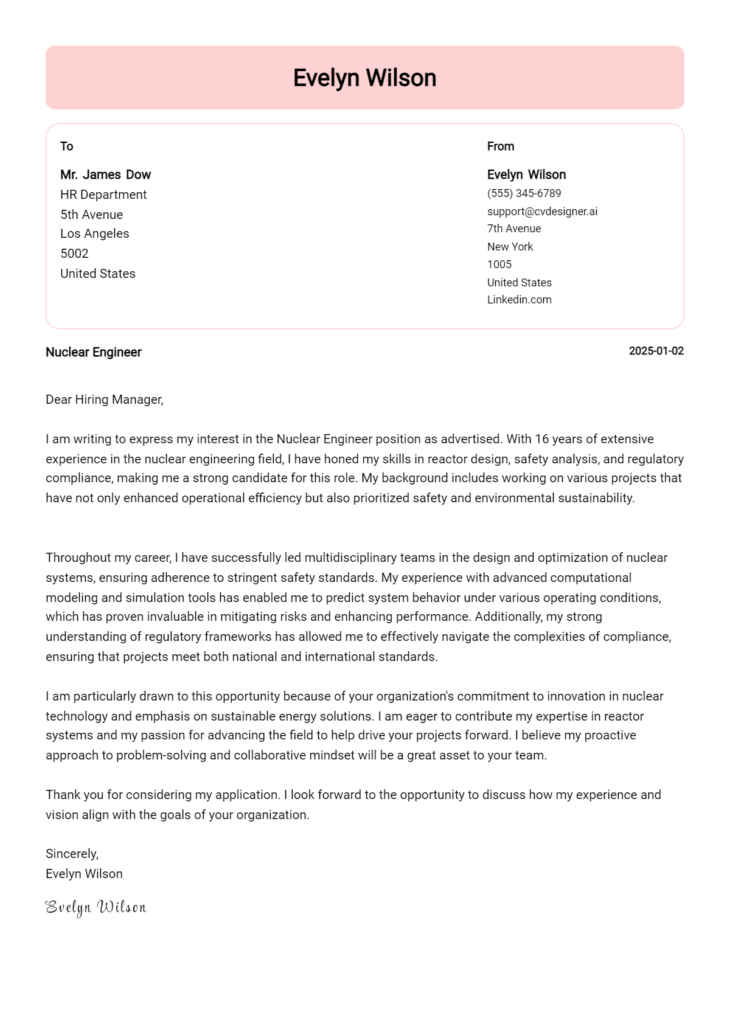Climate Change Analyst Cover Letter Examples
Explore additional Climate Change Analyst cover letter samples and guides and see what works for your level of experience or role.
How to Format a Climate Change Analyst Cover Letter?
Crafting a compelling cover letter is essential for a Climate Change Analyst, as it serves as your first opportunity to demonstrate your commitment to environmental issues and analytical skills. The way you format your cover letter not only reflects your professionalism but also showcases your ability to communicate complex ideas effectively—an invaluable trait in the field of climate science. A well-structured cover letter can capture the attention of hiring managers, providing them with insights into your qualifications and passion for addressing climate challenges.
In this guide, we’ll outline how to structure your cover letter, offering valuable tips and examples tailored for aspiring Climate Change Analysts.
We'll focus on the essential components of a professional cover letter, including:
- Cover Letter Header
- Cover Letter Greeting
- Cover Letter Introduction
- Cover Letter Body
- Cover Letter Closing
Each section is crucial in presenting your qualifications and dedication to the climate change cause. Let’s delve into each part and explore how to make your cover letter shine.
Importance of the Cover Letter Header for a Climate Change Analyst
The header of a cover letter is a critical component that sets the tone for the entire document. It provides essential contact information and establishes a professional image, which is particularly important in fields such as climate change analysis, where attention to detail and clarity are paramount. A well-structured header should include your name, address, phone number, email, the date, and the recipient's name and address. This information not only makes it easy for the hiring manager to reach you but also demonstrates your organizational skills and professionalism.
A strong header reflects your ability to communicate effectively, a necessary skill for a Climate Change Analyst who may need to present complex data and findings clearly. Conversely, a weak header can create a negative first impression, suggesting carelessness or a lack of attention to detail.
Strong Example
Jane Doe 123 Green Street Eco City, EC 12345 (555) 123-4567 jane.doe@email.com October 1, 2023 Mr. John Smith Hiring Manager Environmental Solutions Inc. 456 Blue Avenue Eco City, EC 54321
Weak Example
jane doe email: jane.doe@email.com 10/1/23 To whom it may concern
The Importance of the Cover Letter Greeting
The greeting of a cover letter plays a crucial role in setting the tone for the rest of the document. It is the first point of contact with the hiring manager and reflects your professionalism and attention to detail. Addressing the hiring manager directly personalizes your application, making it more engaging and demonstrating your genuine interest in the position. A well-crafted greeting can create a positive first impression, while a generic one can suggest a lack of effort or research. To avoid generic greetings, take the time to research the recipient's name, which can often be found on the company website or LinkedIn.
Strong Example
Dear Dr. Smith,
Weak Example
To Whom It May Concern,
The Importance of a Well-Crafted Cover Letter Introduction for a Climate Change Analyst
A well-crafted cover letter introduction is crucial for a Climate Change Analyst, as it serves as the first impression to the hiring manager. This opening paragraph must not only capture attention but also express genuine interest in the role. It should succinctly showcase relevant skills or achievements that align with the position, setting the stage for a compelling narrative throughout the rest of the cover letter. A strong introduction can differentiate a candidate in a competitive field, while a weak one may leave a hiring manager uninterested.
Strong Example
Dear Hiring Manager, As a passionate advocate for sustainable development with over five years of experience in climate data analysis, I was thrilled to discover the Climate Change Analyst position at [Company Name]. My work at [Previous Company] involved leading a team in the successful implementation of a carbon footprint reduction program that decreased emissions by 30% within two years. I am eager to bring my analytical skills and dedication to impactful environmental solutions to your esteemed organization.
Weak Example
To Whom It May Concern, I am writing to apply for the Climate Change Analyst position. I think it would be a good job for me because I have a degree in environmental science. I have done some work in this area, but I am not sure what else to say.
Purpose of the Cover Letter Body for a Climate Change Analyst
The cover letter body for a Climate Change Analyst serves as a vital opportunity for the candidate to showcase their specific skills, relevant experiences, and unique value proposition to a potential employer. This section allows the applicant to articulate their passion for combating climate change while highlighting projects or accomplishments that demonstrate their expertise in data analysis, policy development, and sustainability practices. By providing concrete examples of previous work, such as successful initiatives that reduced carbon emissions or innovative research findings that influenced environmental policy, the candidate can effectively convey their qualifications and fit for the role, making a compelling case for their candidacy.
Strong Example
I successfully led a project that analyzed the impact of urban heat islands on local biodiversity, resulting in a comprehensive report that was presented to the city council. This initiative not only identified critical areas for green infrastructure investment but also recommended specific policies that led to a 20% reduction in local temperatures. My experience collaborating with interdisciplinary teams and engaging stakeholders has equipped me with the skills necessary to drive impactful climate action at your organization.
Weak Example
I have worked on climate change issues in the past and I think I would be a good fit for this job. I have done some research and have a degree in environmental science. I believe I can contribute to your company’s goals related to climate change.
Importance of the Cover Letter Closing for a Climate Change Analyst
The closing paragraph of a cover letter is crucial for leaving a lasting impression on the hiring manager. For a Climate Change Analyst, it should effectively summarize the candidate's qualifications, reiterate their enthusiasm for the role, and encourage the next steps in the hiring process, such as reviewing the resume or scheduling an interview. A strong closing reinforces the candidate's commitment to addressing climate issues, while a weak closing may leave the reader uncertain about the candidate's interest or qualifications.
Strong Example
Thank you for considering my application for the Climate Change Analyst position. With a Master's degree in Environmental Science and over five years of experience in climate impact assessments, I am excited about the opportunity to contribute to your team's efforts in combating climate change. I am eager to bring my analytical skills and passion for sustainability to your organization. I look forward to the possibility of discussing my application further and am available for an interview at your earliest convenience. Please find my resume attached for your review.
Weak Example
Thanks for reading my letter. I think I could do this job or something like it. I hope you look at my resume. Let me know if you want to talk more.
These tips will help candidates craft an effective cover letter for a Climate Change Analyst position by emphasizing key attributes that employers are looking for. It’s vital to showcase your technical skills, problem-solving abilities, knowledge of the software development life cycle (SDLC), teamwork experience, and a passion for continuous learning. An impactful cover letter can set you apart in this competitive field.
Tips for Writing a Climate Change Analyst Cover Letter
Highlight Relevant Technical Skills: Clearly outline your technical expertise related to climate change analysis, such as data modeling, statistical analysis, and proficiency in environmental software tools. Mention specific programs you are familiar with, like GIS or climate simulation models. Including these details can showcase your capability to handle complex datasets and contribute to impactful projects.
Demonstrate Problem-Solving Abilities: Employers value candidates who can identify issues and propose effective solutions. Provide examples from your past experiences where you successfully addressed climate-related challenges. Discuss the methodologies you employed, the outcomes, and how your approach aligns with the organization’s goals.
Showcase Your Knowledge of SDLC: Understanding the Software Development Life Cycle is crucial if your role involves developing or managing software tools for climate data analysis. Briefly explain your experience with SDLC phases, such as requirements gathering, design, implementation, and testing, and how it applies to your work in climate change research or projects.
Emphasize Teamwork and Collaboration: Climate change initiatives often require a collaborative effort across multiple disciplines. Share experiences where you worked effectively within a team, highlighting your ability to communicate and cooperate with diverse stakeholders. Mention any interdisciplinary projects that illustrate your ability to bridge gaps and foster teamwork.
Express Your Passion for Continuous Learning: The field of climate change is ever-evolving. Convey your enthusiasm for staying updated on the latest research, technologies, and policies. Mention any relevant certifications, workshops, or courses you have completed or are pursuing. This demonstrates your commitment to personal growth and staying at the forefront of climate change solutions.
By following these tips, you can create a compelling cover letter that effectively communicates your qualifications for a Climate Change Analyst position. For more assistance, consider using cover letter templates or a cover letter builder to streamline your writing process.
Common Mistakes to Avoid in a Climate Change Analyst Cover Letter
Crafting a compelling cover letter is essential for securing a position as a Climate Change Analyst, as it serves as your first impression to potential employers. Avoiding common mistakes can significantly enhance your chances of success. Here are some pitfalls to watch out for:
Generic Content: Tailoring your cover letter to the specific role is vital. Avoid using a one-size-fits-all approach. Research the organization and reflect their values in your letter.
Neglecting to Highlight Relevant Skills: Focusing on unrelated experiences can weaken your application. Emphasize skills such as data analysis, environmental policy knowledge, and research abilities that are directly applicable to the role.
Poor Formatting: A disorganized cover letter can detract from your message. Follow a professional cover letter format to ensure clarity and readability.
Typos and Grammatical Errors: Mistakes can create a negative impression. Proofread your letter multiple times, and consider using tools or getting a peer review to catch errors.
Failing to Showcase Passion for Climate Issues: Employers seek candidates who are genuinely passionate about climate change. Share your motivations and commitment to environmental sustainability.
Overly Lengthy Letters: A cover letter should be concise and focused. Aim for one page, highlighting your most relevant experiences and skills without unnecessary detail.
Ignoring the Call to Action: Conclude your letter with a strong call to action, expressing your eagerness for an interview. This shows initiative and interest.
For more insights, check out these cover letter examples to guide your writing process. By steering clear of these common mistakes, you can create a powerful cover letter that effectively conveys your suitability for the Climate Change Analyst position.
Cover Letter FAQs for Climate Change Analyst
What should I include in my cover letter for a Climate Change Analyst position?
In your cover letter, you should include an introduction that outlines your interest in the position and a brief overview of your qualifications. Highlight your relevant education, such as degrees in environmental science, climate change, or policy analysis. Discuss your experience with data analysis, research methodologies, and familiarity with climate models or environmental policies. Mention any specific projects or accomplishments that demonstrate your ability to analyze climate-related data effectively. Finally, express your passion for sustainability and your commitment to addressing climate change challenges. Tailor your content to the specific job description to show how your skills align with the organization’s goals.
How can I demonstrate my passion for climate change in my cover letter?
To effectively demonstrate your passion for climate change in your cover letter, share personal experiences that led you to pursue a career in this field, such as volunteer work, internships, or relevant coursework. Discuss any involvement in climate advocacy, research projects, or community initiatives that showcase your commitment to sustainability. Highlight specific challenges you’ve addressed or solutions you’ve proposed in previous roles, emphasizing your proactive approach. Additionally, reference your knowledge of current climate issues and policies, demonstrating that you stay informed and engaged with the latest developments. This personal touch not only conveys your enthusiasm but also makes your application memorable.
How do I tailor my cover letter for a specific Climate Change Analyst job?
To tailor your cover letter for a specific Climate Change Analyst position, begin by thoroughly reviewing the job description and identifying key skills and qualifications the employer seeks. Use these insights to adjust your language and focus within your cover letter. Highlight relevant experiences that align with the job requirements, such as technical skills in data analysis, experience with climate modeling, or knowledge of regulatory frameworks. Incorporate specific terminology from the job posting to demonstrate your understanding of the role. Additionally, research the organization’s mission and current projects to show how your values and expertise align with their objectives, thereby making a strong case for your candidacy.
What format should I use for my cover letter as a Climate Change Analyst?
For your cover letter as a Climate Change Analyst, stick to a professional format that enhances readability. Use a standard letter format with your name and contact information at the top, followed by the date and the employer’s contact details. Choose a clean, professional font like Arial or Times New Roman, and keep the font size between 10-12 points. Aim for a one-page length, maintaining clear paragraphs for each section: introduction, body, and conclusion. Use concise language and avoid jargon unless it's commonly understood in the climate change field. Finally, ensure your cover letter is free of grammatical errors and typos, showcasing your attention to detail and professionalism.
Build your Cover Letter in minutes
Use an AI-powered cover letter builder and have your letter done in 5 minutes. Just select your template and our software will guide you through the process.


